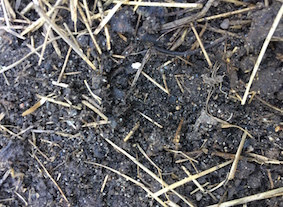+86- 111****
Boluo county dragon Lotus Lake Village Town Industrial Park, China

I know how it goes: It’s mid October, you’re harvesting the last of your summer crops and after the weekend you just want to put down the garden rake and pick up a good book. I don’t blame you! But before you pick up War & Peace, prepare your garden bed for healthy garden soil next spring.
First, what exactly is “healthy” soil? It’s the capacity of a soil to function for the benefit of sustaining plants, and therefore also animals and humans. Healthy soil is filled with microbes—up to 1 billion bacteria per teaspoon!—which then are the food sources for the next level up the soil biology food chain. Eventually the byproducts of this soil biology are absorbed by a plant’s root system. So, healthy soils mean healthy plants.
To keep that soil biology going through the winter and from year to year—to build and maintain healthier soils—we follow a 4-step process. Don’t’ worry, it doesn’t take a lot of effort. In fact, you may even decrease some of your typical gardening effort. You’ll see what I mean in a moment.
Step 1: Keep soil covered throughout the year.
Yes, even during the non-gardening winter season! You can do this with actual crops in summer, or with mulch for places where your crops are absent or during the winter months. Covering the soil helps prevent erosion, lessens the amount of weeds and keeps the soil somewhat moist. All of these things help protect the soil biology and promote healthy garden soil.
Step 2. Keep a living root in the ground.
The benefits of living roots in the soil are that they provide food for those soil microorganisms by bringing atmospheric oxygen down into the soil, and they help create pores through compacted soils. During the gardening season it’s not all that difficult to keep a living root in the ground. In the winter, however, we can use a cover crop such as winter rye, oats or wheat. Even if the crop dies during winter weather, such as would happen with a winter oats cover crop, the dead tissues still protect the soil from sun and erosion, while slowly leaching nutrients into the soil.
Step 3. Increase plant diversity.
The more types of plants—and thus roots—in a garden, the greater the different types of chemistry going on in the soil, and thus the more types of soil biology are present—resulting in healthy garden soil. Legumes, for instance, bring atmospheric nitrogen to the soil. Increasing diversity within the garden and from year to year also helps prevent soil diseases and pests from gaining a foothold in the garden. This is the main reason we rotate crops in a garden from year to year, placing tomatoes next year where the peas were last year and the zucchini were the year before that.
Step 4. Minimize tilling or disturbing the soil deeply.
Lastly, we work so hard to create a soil rich in microbes and filled with pockets of pore spaces. Why destroy this by tilling it all up? Tilling soil deeply collapses the spaces in which air and water hang out in the soil, and where plants can access them. It also compacts the soil, making it hard for roots to penetrate. Using a trowel to dig a hole to plant transplants does minimal damage to deeper soils, where it’s important to keep soil integrity.
So, what can you do now? Plant a cover crop, keep your soil covered and keep some living roots in the ground. Over the winter come up with a plan for how you’ll increase your garden’s plant diversity. Your soil will thank you with a much improved harvest.